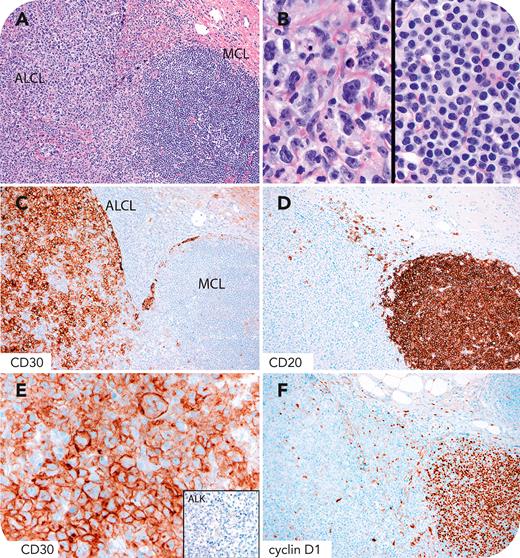A 70-year-old man with high-grade urothelial carcinoma presented with submandibular swelling. Imaging showed diffuse lymphadenopathy suspicious for metastatic disease. Cervical lymph node core biopsy showed T-cell lymphoma and no carcinoma. Given this unexpected diagnosis, an excisional biopsy was performed and showed anaplastic lymphoma kinase (ALK)–negative anaplastic large-cell lymphoma (ALCL) (panel A, original magnification ×10; panel B, left, original magnification ×60; panel C, original magnification ×10; panel E, original magnification ×40; and panel E, inset, original magnification ×10), positive for CD30, CD2, CD5, CD3+/−, and CD4+/−; negative for CD7, CD8, CD20, and cytotoxic markers, and mantle cell lymphoma (MCL) (panel A; panel B, right, original magnification ×60; panel D, original magnification ×10; and panel F, original magnification ×10); positive for CD20 and cyclin D1; and negative for CD5, CD10, bcl-6, and SOX11. A diagnosis of composite ALK-negative ALCL and CD5-negative MCL was established. Fluorescence in situ hybridization was negative for DUSP22(IRF4) and TP63 rearrangements in the ALCL, whereas the MCL was positive for t(11;14)(q13;q32)(IGH::CCND1). The patient received treatment with brentuximab vedotin/cyclophosphamide/etoposide/prednisone. Five cycles after therapy, the patient showed marked interval response. He underwent autologous stem cell transplant but was lost to follow-up after discharge.
Composite non-Hodgkin T-cell/B-cell lymphomas are rare. Proposed etiologies include clonal selection, parallel development of two malignant clones from a common precursor, genomic instability, uncontrolled Epstein-Barr virus (EBV)–infected B cells affecting T-cell growth/maturation, or immunosuppression. In our case, the pathogenesis and the EBV status are unknown. There is no established standard of care for composite lymphomas. Chemotherapy is directed toward the most aggressive component, as done here.
For additional images, visit the ASH Image Bank, a reference and teaching tool that is continually updated with new atlas and case study images. For more information, visit http://imagebank.hematology.org


This feature is available to Subscribers Only
Sign In or Create an Account Close Modal